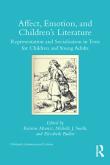AustLit
 3210915380222108460.jpg
3210915380222108460.jpg
Image courtesy of publisher's website.
y
 Affect, Emotion, and Children's Literature : Representation and Socialisation in Texts for Children and Young Adults
anthology
Affect, Emotion, and Children's Literature : Representation and Socialisation in Texts for Children and Young Adults
anthology
 Affect, Emotion, and Children's Literature : Representation and Socialisation in Texts for Children and Young Adults
anthology
Affect, Emotion, and Children's Literature : Representation and Socialisation in Texts for Children and Young Adults
anthology
Issue Details:
First known date:
2018...
2018
Affect, Emotion, and Children's Literature : Representation and Socialisation in Texts for Children and Young Adults
The material on this page is available to AustLit subscribers. If you are a subscriber or are from a subscribing organisation, please log in to gain full access. To explore options for subscribing to this unique teaching, research, and publishing resource for Australian culture and storytelling, please contact us or find out more.

